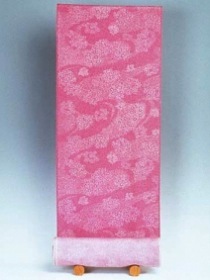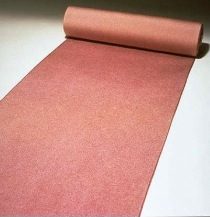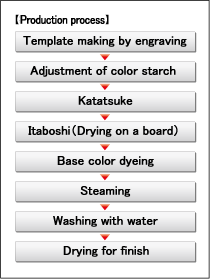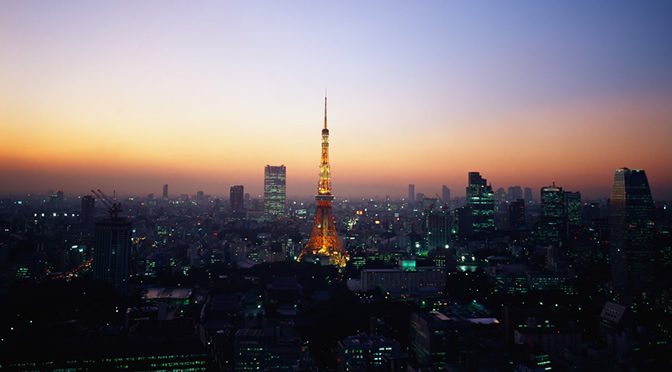 Histry of Tokyo Somekomon
Histry of Tokyo Somekomon
Originated from samurai families in Muromachi Period.Spread to samurais and common citizens, then became Edo’s style.
 It is said that symbols put on Kawadokoro (parts made with leather) of Yoroi and used as crests of Samurai families in Muromachi Period are the origins of Tokyo Somekomon. Later in Edo Period, number of samurais coming up to Edo (Tokyo) accompanying feudal lords started increasing. Consequently, Kamishimo (one of formal dresses of samurai) Komon started being produced. In the middle of Edo Period, Komon stareted being put also on Kimono of common citizens, and became popular as Edo’s style. People in Edo well accepted the style. In Meiji Period and later, the Kimono developed to women’s one such as ceremonial dress.
It is said that symbols put on Kawadokoro (parts made with leather) of Yoroi and used as crests of Samurai families in Muromachi Period are the origins of Tokyo Somekomon. Later in Edo Period, number of samurais coming up to Edo (Tokyo) accompanying feudal lords started increasing. Consequently, Kamishimo (one of formal dresses of samurai) Komon started being produced. In the middle of Edo Period, Komon stareted being put also on Kimono of common citizens, and became popular as Edo’s style. People in Edo well accepted the style. In Meiji Period and later, the Kimono developed to women’s one such as ceremonial dress.
 Charm of Tokyo Somekomon
Charm of Tokyo Somekomon
Delicate patterns and single color come together.
Less self-assertive dandyism makes people enchanted.
 In general, Komon stands for Kimono with small patterns realized by using templates. Tokyo Somekomon (Edo Komon) in particular is featured with fine geometric patterns and single color. Even with a single color, Tokyo Somekomon is in its style and spirited with elegance. Also, as the patterns are small, it looks as if no patterns when looking from a distance, but as coming closer you will find the beautiful patterns and be fascinated with it. This way of less self-assertive dandyism represents the style of Edo. Not only for Kimono, Tokyo Somekomon is now deployed to some others such as scarfs and lampshades, adopting trends today.
In general, Komon stands for Kimono with small patterns realized by using templates. Tokyo Somekomon (Edo Komon) in particular is featured with fine geometric patterns and single color. Even with a single color, Tokyo Somekomon is in its style and spirited with elegance. Also, as the patterns are small, it looks as if no patterns when looking from a distance, but as coming closer you will find the beautiful patterns and be fascinated with it. This way of less self-assertive dandyism represents the style of Edo. Not only for Kimono, Tokyo Somekomon is now deployed to some others such as scarfs and lampshades, adopting trends today.
 The Way of Making Tokyo Somekomon
The Way of Making Tokyo Somekomon
Misalignment, even slight, makes all ruined.
Techniques collaboratively brought by template engraver and dyeing craftsman.
 Tokyo Somekomon is completed through coorperative work by engraver who makes template paper and dyeing craftsman who performs dyeing. Template paper is primarily made with Ise template paper. Dyeing craftsman starts working by receiving template with detailed patterns engraver created by using carving knives. First, dyeing craftsman makes necessary adjustments of color starch. The process, affecting quality of dyeing, requires highly skilled craftsman’s techniques. Next is stenciling, placing template on the white cloth, then putting resist paste. This is a technically difficult process because the pattern is detailed and, misalignment, even for diameter of single hair, gives the white cloth undesired lines. Going through Itaboshi, base-color dyeing, steaming, water wash, and drying, Tokyo Somekomon becomes complete.
Tokyo Somekomon is completed through coorperative work by engraver who makes template paper and dyeing craftsman who performs dyeing. Template paper is primarily made with Ise template paper. Dyeing craftsman starts working by receiving template with detailed patterns engraver created by using carving knives. First, dyeing craftsman makes necessary adjustments of color starch. The process, affecting quality of dyeing, requires highly skilled craftsman’s techniques. Next is stenciling, placing template on the white cloth, then putting resist paste. This is a technically difficult process because the pattern is detailed and, misalignment, even for diameter of single hair, gives the white cloth undesired lines. Going through Itaboshi, base-color dyeing, steaming, water wash, and drying, Tokyo Somekomon becomes complete.
| Main producing center and base | Tokyo Metropolitan |
| Associated occupation | Dyeing Craftsman |
| Commodities | Kimono Tabrics, Haori coat |
| More Information | Tokyo Metropolitan dyeing industry cooperative association Tokyo Somekomon(Traditional crafts in Itabashi-ku) |

